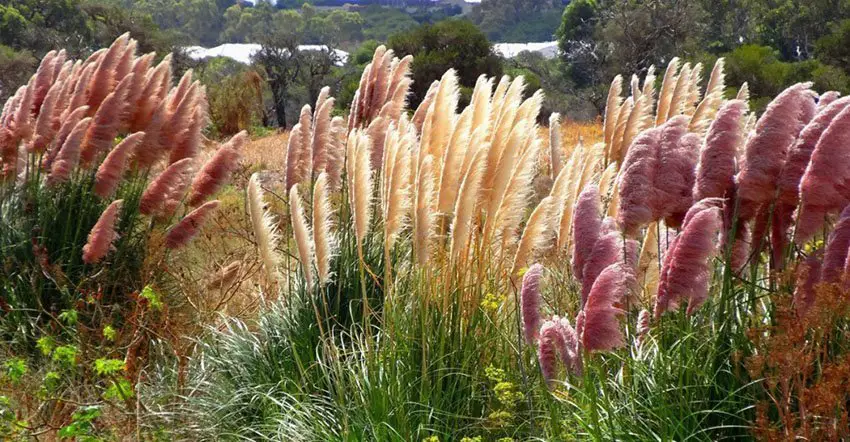How To Kill Pampas Grass – The Best Things You Can Do!

It’s time for the pampas grass to go.
Maybe you moved in to a new home and tried to figure out what those 10 foot tall clumps of alien-looking grass were, blocking out the sun. Or maybe you decided the experiment to recreate your Argentinian vacation in your home is now officially a failed experiment, and it’s time to move on.
Either way, we’ve got a few tips for you that should help in your quest to eradicate this invasive species (at least in the Northern Hemisphere). So let’s get to it!

What Is Pampas Grass Exactly
Before anything else, let us first talk about what exactly is pampas grass. It’s a South American grass that is recognizable for its height and flowering plumes. It’s very happy in hot summers and mild winters. Droughts don’t particularly bother Pampass – it takes an epic one to cause them trouble. They don’t mind wind or salt spray – hence the popularity in beach locations.
There are many people who consider this as an excellent addition to their landscape as an ornamental grass.
One annoying characteristic of this grass is the sharp foilage. It’s easy to get cut on the hand or body when handling their leaves, so you need to cover yourself with long sleeves and gloves to protect yourself.
However, they grow like a weed in more favorable environments. It’s not uncommon for pampas clumps to reach over 10 feet tall AND wide. What looked like an accent at 3 feet tall can take over your entire yard. It can easily go invasive due to the 100,000 seeds they produce per flower head; now you’re battling with a monster on the loose.
Effective Ways to Kill Pampas Grass
Cut Pampas Grass Back To The Ground
Unfortunately, it takes some work to conquer this grass. It’s best to cut the plant down as low as you can to the ground. This is done for two reasons.
First, these plants can get big. It’s just easier to deal with the plant if you can see into it – and that’s hard to do when it’s 10 feet tall. So either get out a hedge trimmer or a weed wacker with a sturdy line or blade to cut it down, and soon you’ll be able to see what you are dealing with. You’ll be able to spray less herbicide and apply it with more accuracy – which is better for you and the environment.
The second reason to cut down the grass has to do with how it responds. Cutting encourages new growth in this grass. Yes, I did say encourage growth. And no, I’m not crazy.
When we cut the grass, it begins to send (for lack of a better term) “growth signals” throughout the plant. This means it’s primed to absorb nutrients and minerals from the ground. It’ll also be more likely to absorb our plant death-potion we’ll apply in the next step. Cue the evil genius laughter…
Apply Post-Emergent Herbicide
Now we need to apply some chemicals. You are looking for post-emergent herbicide rather than pre-emergent. Popular chemical types are Glyphosate and Haloxyfop. Round-up is one brand name – head to your garden supply store to see what is available.
You want to apply the chemical to the tops and sides of the cut grass. Because every herbicide chemical formulation is different, follow the instructions on the bottle for what water-to-chemical ratio you should use.
This video shows how roundup can be applied – your job will be easier since the plant you are dealing with wil be cut back.
Usually it will take one or two applications tops to kill a clump. Larger and more hearty plants can take more time and applications unfortunately.
Once the grass has died following the application of herbicide, there are basically two things that you can do. For people who seem to be too lazy, they often end up just leaving it on the ground. After all, since it is already dead, it would basically just decompose.
For others, meanwhile, they opt to pull the grass manually, especially if they cannot wait for the grass to rot since they would like to start planting already. If you go this route, you’ll probably be amazed how widespread the root system really is.
Non-Chemical Alternatives To Control Pampas Grass
I’m generally in the camp of “the less chemicals the better”. In the case of getting rid of pampas grass, herbicide is really the best way to effectively kill the clumps. In case you are more militant in your herbicide aversion, I’ve pulled together a few other ways to tame the beast. These won’t be as quick, easy or necessarily 100% effective but they have worked for someone in the past.
Salt The Earth
Once you cut the grass back, you can pour salt on the grass to try to kill it. The problem with this is pampas grass can tolerate salt, so you need A LOT of salt. One gardener said he required 5 pounds of ice-cream making salt to take care of a medium plant. That’s a lot.
Of course, this solution isn’t good if you want to plant in the salted location. Most plants don’t love salt.
Burn The Clump
If you are just looking to take care of the problem for 6 to 12 months, burning the grass can work. Of course, this is dangerous – especially in urban areas and in ones prone to wildfires. It’s also not permanent – the act of burning can bring about new growth within a year. Often the fire can make the grass taller and stronger than before.
It does take care of the immediate problem quickly. I wouldn’t do it however.
Cover Up The Problem
If you have enough time, you can kill a clump of pampas grass by cutting it low and then covering it with a thick tarp. The object is to let no light or direct moisture get to the grass – and let time slowly send the grass into the cold dark night.
This will take time – not days but likely weeks to months. This grass is hearty, and not going down easy. It’s best to try for a few growing seasons of covering to ensure the plant is really done. From what I’ve read, this method will work if you can wait long enough. Most people don’t have that kind of patience and pull the tarp too soon. Sure enough, the next spring the grass comes back from the dead.
One way to help your odds is to cover and dig out as many roots as you can once you remove the tarp. It’s hard work – but no chemicals involved.
If you have any other tips or tricks, please share them in the comments below.


I have 10 clumps in my meadow …I will take your advice about cutting it down, but I think I may try 93% acetic acid and then solarize the area for the rest of the summer….( thick, clear plastic that will heat down about a foot to kill the roots). thanks for the post!